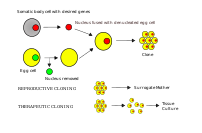 Image via Wikipedia
Image via Wikipedia
[amazon_link asins=’B074W5M8WD,B01FWNMN04,1523255137,B01MG6XSLA,B01EIX5EA0,0996614516′ template=’ProductCarousel’ store=’finmeacur-20′ marketplace=’US’ link_id=’b4e8e811-8885-11e7-aacb-27fc6658b19b’]
Using laboratory mice that have Parkinson’s disease, scientists have taken therapeutic cloning a step further by taking healthy cells and transplanting them into their brain.
Although successful with rats, scientists are a long way from doing such experiments with human beings. (Below) Dolly, the first animal to be cloned
It is the Holy Grail of therapeutic cloning, at least for the next decade or two. Biomedical scientists have always wanted to develop a method of treating people with serious degenerative diseases by using cells derived from them. While no one doubts whether this will be possible one day, the path towards this goal is strewn with obstacles and problems, even in animal models. Now some scientists have achieved the first success in mice that have Parkinson’s disease.
Scientists at the Memorial Sloan-Kettering Cancer Centre (MSKCC) in New York and the Riken Institute in Kobe, Japan, took cells from the tail of mice and transplanted them — after some engineering and cloning — into their brain. These mice had induced Parkinson’s disease, and showed improvement in their brain function soon after the transplant. “This is the first time cells from the same animal have been cloned and transplanted into another part,†says Mark Tomishima, scientist at MSKCC.
All the attempts at therapeutic cloning so far have been using cells from a donor. This is fine in research, because all the mice used in such work in a lab are genetically identical. However, it is of no use in humans because no two human beings — or no two animals in the outside world — are genetically alike (barring identical twins). If you transplant cells from one animal to another, they are immediately rejected by the recipient.
So the current research has important implications for treating many degenerative diseases. It could, sometime in the near future, help doctors treat patients with organ damage using cells derived from them. However, there is still some way to go before the research advances into clinical trials in human beings.
The word therapeutic cloning is, in some ways, a misnomer. Cloning is the technique through which you produce identical copies of something: a piece of DNA, a cell or an entire organism like in the case of the sheep Dolly. Therapeutic cloning, on the other hand, starts with an ovum — or egg — with its nucleus coming from a donor. This ovum is used to create stem cells that are used currently in research. This technique is better known in the scientific world as somatic cell nuclear transfer. It was also the technique used to create Dolly, but most biologists consider it reaching a dead end as far as creating copies of a human being is concerned. Its potential in regenerative medicine, however, is enormous.
Regenerative medicine is the technique of regenerating lost cells, tissues or organs in the body. People lose their tissues or organs in a large number of diseases, not to speak of injuries from accidents. This ranges from the loss of kidney or liver function to many diseases of the nervous system. The loss of function also happens in the retina through diseases like macular degeneration, in the bone marrow through chemotherapy, in virtually any tissue or organ in the body. The body does not replace these lost tissues. Modern medicine has no satisfactory way to replace them either.
Strictly speaking, regenerative medicine is at least three decades old. Stem cells from a donor bone marrow are routinely being transplanted in patients after chemotherapy. Sometimes, bone marrow cells are removed from the patient before chemotherapy and put back after the treatment. Now medical researchers have begun using embryonic stem cells to grow bone, treat heart disease, cancer and many other ailments. In the future, however, regenerative medicine could use somatic cell nuclear transfer — and not embryonic stem cells — to regenerate cells in any tissue.
Parkinson’s disease is one of the many diseases of the brain that would benefit from somatic cell nuclear transfer. This disease results from the loss of neurons — brain cells — that produce a chemical called dopamine. Once lost, there is no way for the body to replace these neurons. So the only way is to supply fresh neurons that still have the ability to produce dopamine. We could, in theory, take stem cells from the patient’s body and put them in the brain. These stem cells would, again in theory, become neurons and produce dopamine. However, scientists are a long way from doing such experiments with human beings.
Scientists at the Sloan-Kettering Cancer Centre and Riken Institute have now achieved somatic cell nuclear transfer in mice for the first time. They have also used this technique to show that it works when used to treat Parkinson’s disease. The next stage is to advance the method to higher animals. “This method is too expensive and difficult to try in human beings,†says Tomishima. However, before reaching human beings, the technique has to be tried at least in monkeys.
Scientists recently showed that it is possible to produce stem cells in monkeys through somatic cell nuclear transfer. In November last year, Nature published research by scientists at the Oregon National Primate Research Centre and Oregon Stem Cell Centre and other institutes in the US. The researchers had produced genetically identical — to the donor — stem cells in monkeys through nuclear transfer. Now someone has to take these cells and transplant them to the brain or any other tissue and show that they regenerate. So there is still some way to go before scientists start treating human beings, but therapeutic cloning has reached one more major milestone
Click to see also:->Therapeutic cloning offers hope of treatment
Sources: The Telegraph (Kolkata, India)
